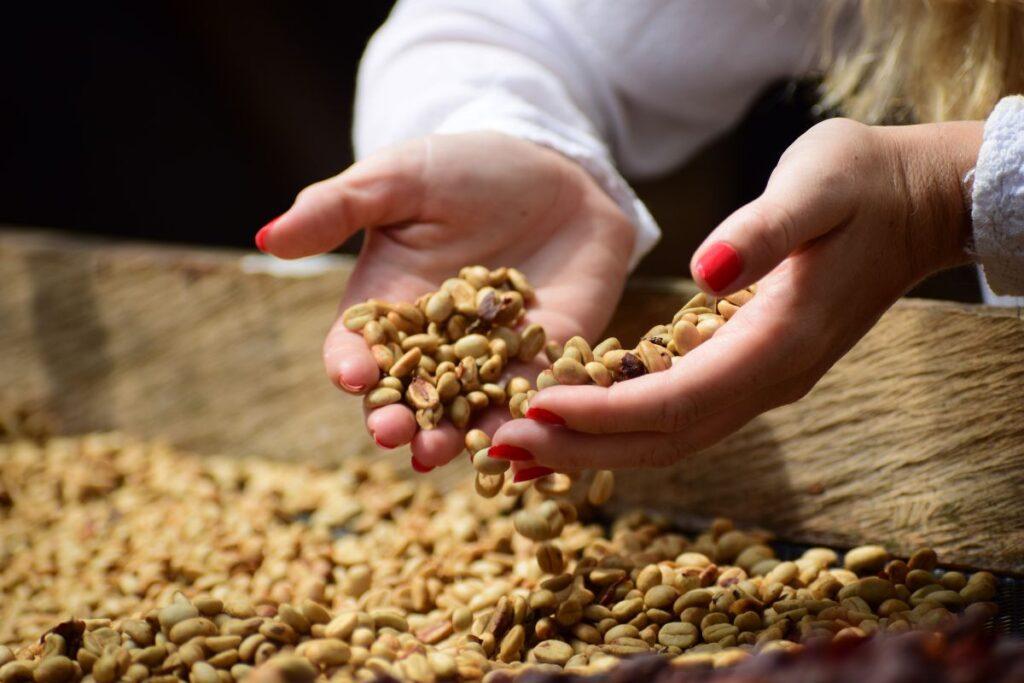About 1 in every 2 Americans consumes coffee. That’s like 150 million Americans. It’s no wonder that the US is the biggest coffee consumer in the world!
But how much do we know about coffee production in the US?
Ditch the idea that coffee is only grown abroad, in third-world countries. That’s so untrue!
Here’s all you need to know about coffee production in the US.
By Lilian.
Affiliate disclosure
This page may contain affiliate links – we may earn a small commission when you make a purchase through these links. This is at no extra cost to you.
Hawaii is the Only US State That Grows Coffee Beans for Commercial Purposes
Besides the beautiful sandy beaches that Hawaii is well known for, they also produce coffee!
I did the research and found 7 important facts about coffee production in Hawaii.
Read on!
Hawaii Has Over 600 Coffee Farms
The farms are mainly on the Big Island, Hawaii. Other coffee farms are in Oahu, Molokai, Kauai and Maui.
Tip: Did you know that Hawaii farms grow coffee more than any other cash crop?
Most Farms Are Located on the Lower Slopes of Mount Waialeale
Home Grounds mentions that this area receives abundant rainfall and has rich volcanic soils.
Coupled up with a high altitude, you have the perfect coffee farming environment!
Hawaii Produces at Least $25 Million Pounds of Coffee Yearly
According to the Hawaiian Government, coffee production was highest in 2015/2016 at $31 million pounds.
2020 showed a slight decrease to $27 million pounds.
Hawaiian Coffee is less than 1% of Global Coffee
In fact, Hawaiian coffee is just 0.03% of the total coffee produced around the world.
They definitely cannot produce so much coffee because not all regions in Hawaii can support coffee farming.
The few regions that can (mentioned hereafter), have a tropical climate, a high altitude, rich volcanic soils and enjoy high amounts of rainfall throughout the year.
Hawaiian Coffee Beans Don’t All Taste the Same
Coffee Bean Coral highlights that Hawaiian coffee beans taste differently depending on the climate of each growing region.
However, all of them have a very clean, bright and sweet taste with undertones of berry, citrus and milk chocolate.
Many varieties also taste like milk chocolate, molasses and brown sugar. Others also have a floral honey taste!

Kona Coffee Beans Are the Most Popular Hawaiian Coffee Beans
Kona coffee beans grow in Kona District on the Kona coffee belt on the Western Coast of Hawaii.
They are harvested twice a year – March and August.
Experienced farmers hand-pick ripe cherries. Handpicking ensures they get only the ripe cherries, in the best form.
Other Hawaiian Coffee Production Regions
Besides Kona District, coffee also grows in:
- Ka’u·
- Puna
- O’ahu
- Maui
- Kauai
- Molokai
- Hamakua
Before you bash me (in the next section), let me restate that Hawaii is the only US state that produces coffee for commercial purposes.
But that doesn’t mean it’s the only state that produces coffee in the US.
California, Florida and Puerto Rican also produce coffee, although not enough to meet the commercial threshold.
Read on!
California Coffee Beans Are Transforming Coffee in the US
Sooner than later, California will join the list of countries that have a commercial coffee production industry.
But how did it all start?
A Short History of Coffee Production in California
It all started 20 years ago (how old were you then? ha-ha)!
Mark Gaskel, a farm advisor for the University of California, realized that coffee plants were growing in gardens randomly.
He set out to determine whether coffee production in large-scale would become a reality for California.
He liaised with Jay Ruskey – the proprietor of Good Land Organics – in this venture.
In 2002, the two gentlemen planted coffee on Ruskey’s Santa Barbara farm.
The results were so good that Ruskey became a passionate coffee farmer in California.
Probably the first of his kind!
That was just the beginning of a long journey, as more local farmers joined in.
Ruskey’s California Coffee is Among the Best Coffees in the World!
A 2014 review found that coffee beans produced in Ruskey’s farms and marketed under the name ‘Good Land Organics’ are among the top 30 in the world!
It has a pungent, sweetly nut-toned taste with notes of brown sugar, orange and cherry.
It also comes with a lightly syrupy mouthfeel.
The signature is a lily-like floral aftertaste!
There Are At Least 70 Coffee Farms in California
The farms are in Santa Barbara, San Luis Obispo, Ventura, Los Angeles and San Diego.
These farms are home to over 100,000 coffee trees!
Arabica is the Most Common California Coffee
Lindsay Campbell highlights the specific varieties as:
- Caturra Rojo
- Cuicateco
- Mundo Novo
- Geisha
- Pacamar
- Laurina
California Coffee Grows Amidst Avocado Trees
The University of California Agriculture Department made an interesting observation.
That coffee farmers in California plant avocado trees together with coffee shrubs to maximize their profits!
Have You Heard About Puerto Rican Coffee?
Puerto Rico (a US territory but not a state) has been growing coffee as a cash crop since 1736.
In 2020, they produced over 4,100 tons of coffee.
Unfortunately, most Puerto Ricans are coffee lovers, so they only export less than 3% of their total coffee production.
Just so you know, Puerto Rican coffee is sweet and creamy.
Discover Puerto Rico mentions that most people take it without sugar, and as a black coffee.
Is Coffee Grown in Florida?
Yes! Florida farmers grow coffee trees, but not for commercial purposes.
However, Florida could be the next coffee king as scientists project that climate change is likely to favor Florida’s coffee production.
Photos by arifarca and Jennifer Poole





